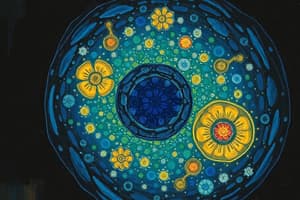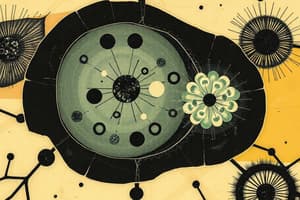Podcast
Questions and Answers
Which of the following correctly describes the function of the cell membrane?
Which of the following correctly describes the function of the cell membrane?
- It controls what enters and leaves the cell. (correct)
- It stores water and nutrients inside the cell.
- It provides structural support to the cell.
- It synthesizes proteins for the cell.
Which of these represent the shape and unique organelles found in plant cells?
Which of these represent the shape and unique organelles found in plant cells?
- Rectangular shape with lysosomes and centrioles.
- Circular shape with chloroplasts and a cell wall.
- Rectangular shape with chloroplasts and a cell wall. (correct)
- Circular shape with lysosomes and centrioles.
If a microscope has a 25x lens, what is the total magnification?
If a microscope has a 25x lens, what is the total magnification?
- 2.5x
- 250x (correct)
- 2500x
- 25x
What is the primary function of the Golgi bodies within a cell?
What is the primary function of the Golgi bodies within a cell?
Which of the following is NOT part of the cell theory?
Which of the following is NOT part of the cell theory?
Flashcards
What is a cell?
What is a cell?
The smallest unit of life that can carry out all the processes of life.
What is the function of the cell membrane?
What is the function of the cell membrane?
Controls what enters and leaves the cell.
What are organelles?
What are organelles?
Organelles are small structures within a cell that perform specific functions.
What is the function of the chloroplast?
What is the function of the chloroplast?
Signup and view all the flashcards
What is the function of the centrosome?
What is the function of the centrosome?
Signup and view all the flashcards
Study Notes
Eukaryotes and Prokaryotes
- Eukaryotes include animals, plants, fungi, and protists.
- Bacteria and archaea are prokaryotes.
- Examples: dog (animal), tree (plant), mushroom (fungus), algae (protist), strep (bacteria).
Cell Theory
- Three parts of cell theory:
- All new cells come from old cells.
- Cells are the smallest unit of life.
- Every living thing is made of cells.
Microscopes
- To calculate total magnification, multiply the microscope's number by 10.
Cell Structure - Plant Cells
- Plant cell shape is rectangular.
- Unique organelles: chloroplast, cell wall.
- Functions:
- Chloroplast: controls photosynthesis.
- Cell wall: protects and supports.
- Central vacuole: stores water, regulates turgor pressure.
Cell Structure - Animal Cells
- Animal cell shape is circular.
- Unique organelles: lysosomes, centrioles.
- Functions:
- Lysosomes: break down waste.
- Centrioles: control cell division.
Cell Organelles and Functions
- Mitochondria: Converts food into energy.
- Golgi bodies: Packages and delivers proteins.
- Organelles: Located within the cell membrane.
- DNA: Found within the cell nucleus.
- Cell membrane: Controls what enters and leaves the cell.
- Rough ER: Stores proteins.
- Smooth ER: Stores fats.
- Centrosome: Controls animal cell division.
- Chloroplast: Controls plant cell division.
- Nucleus: Makes ribosomes.
- Cytoplasm: Contains cell contents.
- Cytoskeleton: Structures, supports, and transports for the cell.
- Ribosome: Makes proteins.
- Vacuoles: Store water and nutrients.
- Vesicles: Transport nutrients.
- Cell membrane: Separates the cell from its environment.
- Cell wall: Protects the cell.
Studying That Suits You
Use AI to generate personalized quizzes and flashcards to suit your learning preferences.
Description
Test your knowledge on eukaryotic and prokaryotic cells, including their structures and functions. Understand the fundamental principles of cell theory and the unique characteristics of plant and animal cells. This quiz covers essential concepts in cellular biology.




